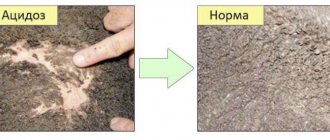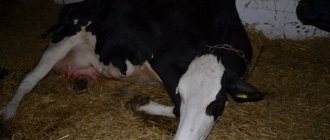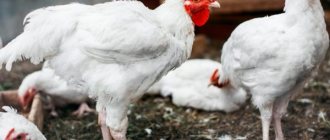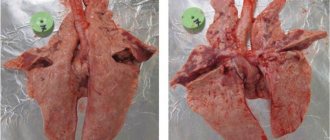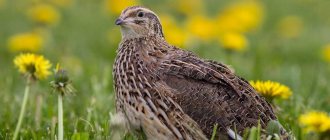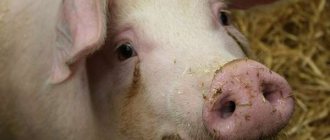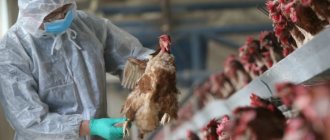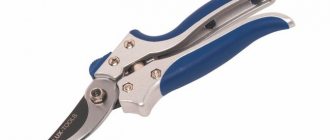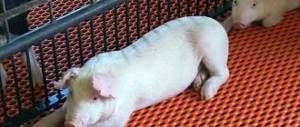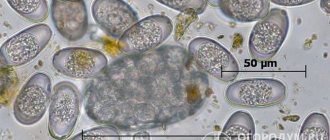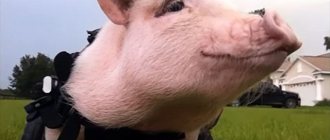Treatment and prevention of coccidiosis in turkey poults
Prevention of coccidiosis in the world
Prevention of this disease and its treatment will largely depend on what drugs are chosen for this.
If one or more sick individuals are noticed in a flock, they must be immediately isolated to stop the spread, and the remaining healthy ones must be given a coccidiostat with food or water. It is best to treat a sick turkey with a single drug, rather than with a whole complex.
If we talk about domestic veterinary drugs, treatment and prevention can be carried out with the following drugs:
- Amprolium (as prevention: 75–125 g (0.0075–0.0125% solution) per ton of feed during the first 7–10 weeks of life; as treatment: 0.25 g (0.025% solution) per kilogram of feed from five days to a week);
- Coccidiovit (as prevention: 0.145 g per kilogram of feed for 7–10 weeks).
Turkey poults
Among the foreign drugs used to treat and prevent coccidiosis in turkey poults, we can highlight:
Degree of coccidia resistance
Zoalen (as prevention: 0.125 g (0.0125% solution) per kilogram of feed for two months; as treatment: the substance is diluted in drinking water (0.37 g per liter) and the birds are given the resulting solution for five days to a week ). This drug can be given to turkey poults from the first days of life. It does not accumulate in the body and is quickly eliminated. Its domestic analogue is called “coccidin”; Baycox (as treatment: dilute the drug in a ratio of 1 ml per liter of water and feed turkeys for up to two days). This medicine is guaranteed to kill all types of coccidia in such a short time and does not conflict with either feed or food additives for turkeys. Solikoks (as treatment: feed the bird with a solution of the drug in a ratio of 2 ml per liter of water for two days). Broad spectrum coccidiostatic agent. A low-toxic drug intended for the treatment of coccidiosis not only in birds, but also in domestic mammals, for example, rabbits or cattle. It can be combined with any feed and medications, and can also be used at high temperatures or high humidity. Amproline VP. A powerful preventive and medicinal agent against coccidiosis. It acts for 24 hours and is then excreted from the body along with feces. It is not absorbed into the bird’s blood at all. Remaining in the stomach and intestines, it kills all types of coccidia. A small dose, administered continuously with water, will prevent the occurrence and development of the disease in turkeys and other domestic animals;
Diacox (as prophylaxis: 1 mg per 1 kg of ready-made food from 1 day of life to 14 weeks of age). Can be given to one bird or to the whole flock. Given with food; Monlar 10% granulate. Produced in Slovenia. It has the appearance of a brownish powder and has a specific odor. Does not dissolve in water. Guaranteed to destroy all types of coxidia, but only moderately toxic. Mixed with food in certain proportions. Has restrictions on compatibility with other substances. It is almost not absorbed into the bird’s body and is excreted in almost unchanged form in feces; Koksitsan 12% granulate. Refers to feed coccidiostats. Absolutely insoluble in water
It is classified as a moderately hazardous substance, so when using it, it is extremely important to strictly follow the instructions for use and dosage. Used primarily for prevention
It is important to exclude it from the feed five days before slaughter.
The best option for protecting against diseases is timely preventive measures. The following substances can prevent the occurrence and spread of coccidiosis, which can lead to mass mortality of birds:
Creolin 100 ml
- Potassium permanganate;
- Formalin solution (3%);
- Slaked lime;
- Creolin emulsion;
- Alkalis of sodium and potassium.
Only treating the poultry housing area with the above solutions can be considered a preventive measure.
Sulfadimethoxine is an excellent help in the fight against coccidia. Medicines for this disease are mixed into food and drink or forcefully administered to each bird in doses recommended by a veterinarian, taking into account the instructions provided by the drug manufacturers. To completely cure a bird, you need to complete the full course from start to finish.
One of the best methods of combating this and other diseases of domestic animals is to maintain cleanliness in their habitats and strictly adhere to sanitary standards and regulations.
How to give medications?
Igor Nikolaev
auto RU
Coccidiostats and antibiotics are mixed with water or feed. If turkeys refuse to eat, then the feeding method will be more effective. However, birds must eat food. It is introduced through a probe into the goiter sac or in the form of balls, which are placed in the oral cavity. How to give drugs:
| № | Helpful information |
| 1 | "Baykoks" - this product is diluted with drink. Dosage 1 ml/l of water. Watering continues for 2 days. After treatment, a stool test is performed. If oocysts are detected in the litter, after 5 days the drug is repeated |
| 2 | "Amprolium" - the medicine can be given to chicks from birth. The drug is administered into the feed at 0.25 g/kg. Duration of treatment 7 days |
| 3 | “Statil” is a low-toxic product and does not accumulate in the body. It is mixed with feed: 0.01 g/kg |
| 4 | “Coccidin” – the medicine is administered into the feed, 250 mg/kg, for 5 days. Next, the dosage is reduced to 125 mg/kg and treatment is continued for another 7 days: the same amount of Coccidin is used as a prophylaxis against infection |
| 5 | “Sulfademisin” – dosage 1 mg/kg of feed. The bird is fed for 3 days with an antibiotic, then take a break for 2 days, and repeat the therapy |
| 6 | “Norsulfazol” - water the birds: 0.5 mg/l of water. Soldering continues for 3 days. If necessary, the antibiotic course is repeated after 7 days. |
More on the topic: Why do turkeys pluck each other's feathers?
After treatment, laboratory tests are performed. On day 27, turkey feces are examined. If oocysts are not detected, then the therapy was effective. Meat and eggs can be sold after 10 days. Unfortunately, not all individuals can survive coccidiosis. A mortality rate of 30% is noted. The carcasses of dead birds are covered with an antiseptic containing ammonia and burned.
Common Turkey Diseases
Diseases of turkeys, both adults and young, as well as their health, are of concern not only to those who grow them; this issue is also of interest to consumers of meat products, the population and even government agencies. Diseases of turkeys are no longer of private, but of national importance. To solve this issue, breeders need to be able to prevent, and if that doesn’t work, then identify and treat any ailment in turkey poults. After all, they are responsible not only for the health of their own individuals, but also for the well-being of their fellow citizens.
The most important place in the fight against diseases is prevention.
Neglect of care and nutrition recommendations, on the contrary, leads to outbreaks of dangerous diseases, as living conditions become unsuitable. Turkeys most often suffer from diseases that are caused by various microorganisms: bacteria and viruses. Failure to comply with sanitary standards creates a nutritious, beneficial environment for all kinds of microbes. Prevention in this situation is the most effective and cheapest method. It also happens that individuals pluck out fluff on their body and head; this can be both a psychological and physical problem.
Causes
The reasons why this disease occurs must be sought in the preparation of the menu for the bird and in the conditions of its keeping. You cannot keep a large number of birds in a small area. It is important to monitor the humidity in the room. Chicks should not be overcooled or, on the contrary, overheated. It is important to follow sanitary standards.
Animals become infected with coccidiosis through drinking bowls, feeders, and bedding that are not maintained in accordance with sanitary standards.
These bacteria multiply best in warm and humid weather. It is very important for the owner to track the bird’s ill health in a timely manner. A clear sign of behavior is that the chicks emit a plaintive squeak.
Prevention of diseases in poults and turkeys from day one
The best treatment is prevention. The following are used as preventive measures:
- treating equipment with boiling water;
- whitewashing walls and ceilings with slaked lime solution;
- a weak solution of potassium permanganate, periodically added to food;
- timely cleaning and disinfection of premises.
Scheme for feeding turkey poults against diseases
To prevent diseases, turkey poults are prescribed drinking water from the first days of life at the following ages:
- from 7 to 10 days - Furazolidone to prevent intestinal diseases;
- from 14 to 20 days - Baycox for the prevention of coccidiosis;
- from 20 to 25 days - antiseptic ASD 2 to increase immunity;
- from 40 to 45 days – Metronidazole to prevent histomoniasis.
Drugs for the treatment of coccidiosis
When the first signs of infection are detected, infected turkey poults are moved to a separate compartment and treated with the following anticoccidial drugs:
- “Baycox” – 1 ml of the drug is dissolved in 1 liter of water. The course of treatment is 5 days. The drug is compatible with all medications and feed additives.
- “Coccidin” - the drug is mixed with the daily amount of dry food at the rate of 2.5 g/kg of live weight that the turkey currently has. The course of treatment, depending on the degree of neglect and severity of the disease, ranges from 3 to 4-5 days. This drug can also be used to prevent coccidiosis at a dose of 1.25 g/kg live weight of poultry for 2-5 days.
- “Eimeterm” – 1 ml of the drug is dissolved in 1 liter of drinking water. The resulting solution is fed to the chicks for 2 days.
- “Solikoks” - turkey poults are given a solution prepared at the rate of 2 ml per 1 liter of water. The duration of treatment with the drug is 5 days.
- "Amprolium" - for the treatment of coccidiosis, the drug is mixed with the feed mixture at the rate of 0.25 g per kg of feed. The duration of treatment is 5-7 days.
- “Stop coccid for turkey poults” - 1 ml of the drug is dissolved in 1 liter of water, the chicks are fed with the solution for 5 days.
- “Coccytox” - according to the instructions for use Coccytox for the treatment of coccidosis, turkey poults are dissolved in clean drinking water used for watering poultry for 48 hours in a ratio of 1:1000 (1 liter per 1 ton of drinking water) or in a ratio of 3:1000 (3 liters per 1 ton of drinking water), feed the bird with this solution for 8 hours for 2 days in a row. In case of severe disease, the course of treatment in the same doses is repeated after 5 days.
Often, in advanced forms, sulfonamides with a broad spectrum of action are used. One of the most common and effective drugs in this group is Sulfadimethoxine. If Sulfadimethoxine is used for turkey poults, the dosage for daily use is determined at the rate of 0.02 g per 1 kg of bird weight for the first 1-2 days, subsequent days - 0.01 g per 1 kg of weight. This potent drug is diluted according to the instructions and added to the feed. The course of treatment for advanced forms of coccidiosis with Sulfadimethoxine lasts 5 days.
Read also: Infectious bursal disease virus
Important! The carcasses of birds that have died from this disease should be immediately removed from the poultry house and burned away from outbuildings. Poults that are not infected must be transferred to another poultry house, and the room must be thoroughly cleaned and disinfected. Such a poultry house can be populated with a new number of turkey poults after 3 weeks to avoid re-infection.
Diseases of a young individual
There are also diseases that affect only young individuals.
Infectious sinusitis
The causes of the disease are: close housing, hypothermia of the bird and lack of vitamins A and D. With sinusitis, the nasal and ocular sinuses become inflamed, in which pus accumulates. The bird's head swells and turns red. Treatment consists of the use of antibiotics - Furazolidone, Oxytetracycline, Streptomycin, Tilan or Farmazin.
Experienced breeders also recommend taking a syringe with a thicker needle (it will be difficult for pus to flow through a thin needle), lay the turkey on its back with its head on one side (it is better to do this together), and pump out the pus from the sinuses by puncturing the swelling. The direction of insertion of the needle should not be towards the eye, so as not to damage it. The needle should enter at an angle, not at a right angle. Pumping out the contents is stopped when the swelling subsides (the skin sag in this area).
Hemophilosis
An infectious incurable disease that usually affects turkey poults up to 5 months old. It is transmitted from a sick individual to a healthy one, as well as through water and food. In chicks, the mucous membranes in the nasopharynx and eyes become inflamed, shortness of breath and wheezing appear, they lose their appetite, and as a result begin to lose weight. At a later stage, the bird's head resembles an owl's in appearance due to severely inflamed suborbital sinuses.
Sick individuals are slaughtered. The rest are given inhalations with iodine and chlorine-turpentine. The room is disinfected with a solution: 2% formaldehyde, the same amount of caustic soda and 20% freshly slaked lime are added to the water. The mixture is heated to 80°C and the entire poultry house is treated.
Paratyphoid
A dangerous disease that affects chicks up to 1 month old. The mortality rate exceeds 70% because the immune system is not yet fully developed.
The chicks practically do not move, sit hunched over, ruffled, they have no appetite, but there is an increased need for water. The drugs used for treatment are Mepatar, Trimerazin and Lauthecin.
Pullorosis (typhoid)
This is a contagious disease that spreads quickly throughout the herd. The main symptom is white diarrhea with pieces of foam and an unpleasant odor. The chicks constantly squeak and their breathing is heavy. They develop blood poisoning, destroying the gastrointestinal tract and respiratory system.
Typhus is transmitted through food, water, dishes, and from sick birds. If the eggs were initially infected, then the turkey poults hatch from it already sick. Chicks at the age of 1 day are most susceptible to the disease; the fatal outcome reaches 70%. Treatment is prescribed by a veterinarian, selecting the right antibiotic after establishing an accurate diagnosis. An obviously sick bird is destroyed. For prevention, chicks are fed Furazolidone from the first day.
Histomoniasis
Turkeys that are kept together with chickens, ducks and geese are more often susceptible to the disease. Turkey poults aged 3 to 21 weeks are at risk. Sick chicks stand passively in the corner, do not eat, their stool is yellow-orange in color, and the skin of the head becomes blue-black. The intestines and liver are affected (the photo shows spots on the liver of a bird with histomoniasis).
For treatment, medications are used - "Trichopol", "Furazolidone", "Metronidazole" and "Osarsol", following the manufacturer's instructions.
How to cure stomatitis in adults
The method of treating stomatitis in adults depends on the root cause and the degree of complexity of the disease. Most often it consists of taking antiviral drugs and external use of healing ointments and creams. In addition to medications, during the treatment period it is necessary to follow a diet, careful oral hygiene, and abstain from alcohol. A dentist-therapist will give precise recommendations that will allow you to cure stomatitis in the shortest possible time.
How to cure stomatitis at home and is it possible? Treatment of stomatitis in most cases is medicinal, so it is possible to eliminate the inflammation at home, but only if the drugs are properly selected. We do not recommend self-medication and taking medications without a doctor’s prescription, since the selection of medications is carried out only after determining the type and stage of the disease. Trust your health to professionals who know how to treat stomatitis quickly and effectively. The doctors at Comfort Dentistry are always happy to help you, please contact us!
Diarrhea in turkey poults: how to treat it
In addition to vaccination, there are a number of preventive measures against coccidiosis. First, you need to make it a habit to observe the appearance and behavior of your pets. It is necessary to constantly monitor the level of humidity in the poultry house.
The poultry house and all equipment for caring for birds must be periodically disinfected. Due to the fact that turkey food takes a very long time to digest, it is necessary to monitor its freshness.
Each individual should be inspected periodically. If symptoms of the disease are detected during these, the individual should be immediately isolated to prevent an epidemic.
The health of each individual is the key to the health of the whole flock. Achieving good results requires a lot of effort.
Symptoms
For fragile chicks, any illness carries a serious danger, so the young animals are monitored especially carefully and strictly. During the first month of life, turkey poults not only quickly gain weight, but also adapt to new conditions, wet mash and dry food, which can become serious stress.
How to find out from external signs why a chick is sick? How to treat diarrhea in turkey poults, and how to prevent it from happening in the future?
If signs of indigestion are detected, experienced poultry farmers advise paying attention to the color of the stool. If turkey poults have brown diarrhea with mush from poorly digested feed, this indicates an unbalanced feed.
Often this reaction is detected when a large number of new fertilizers are introduced at once.
If turkey poults have brown diarrhea with mush from poorly digested feed, this indicates an unbalanced feed. Often such a reaction is detected when a large number of new fertilizers are introduced at once.
However, it is possible that food is given in excess, and the chicks eat mash that has already spoiled. In any case, it is necessary to adjust the distribution rate and balance the composition of the food. As a preventive measure, potassium permanganate is added to the water for turkey poults, and Biovit is added to the feed. In particularly severe cases, they resort to treating diarrhea in turkey poults with antibiotics.
Yellow or greenish stools are of a similar nature, while greenness is a sign of an advanced disease, which is unlikely to be eliminated by simply excluding a suspicious product.
Drops of a dark, almost black color combined with lethargy, drowsiness and unkempt dishevelment are a dangerous sign of poisoning. But the most alarming sign for a poultry farmer is white droppings - a symptom of pullorosis and other serious ailments of poultry.
If diarrhea in turkey poults is not treated immediately, pullorosis leads to convulsions, deterioration of the condition and death. Even after treatment, the chicks remain carriers of the disease for a long time.
A set of preventive measures includes protecting chicks through vaccination against the most dangerous, often fatal diseases. To maintain immunity, rapid growth and weight gain, vitamin feed, specialized complexes and mineral supplements in the form of chalk and shells are introduced into the diet.
In addition to replacing bedding, poultry houses are treated to remove rodents, helminth eggs and harmful insects. The key to the health of young animals will be a place separate from the adult livestock where the growing turkey poults will be spacious, dry and warm.
The following preventive techniques are used:
- Giving coccidiostats with food.
- Feeding turkey poults with anti-eimeriosis drugs.
- Vaccination.
- Disinfection.
The following techniques are used:
- Use of starter feed containing coccidiostats.
- The use of a premix containing drugs that inhibit the vital activity of eimeria. Avatek, Cigro, Nikarmix are in demand.
- Use of medications intended for mixing with feed:
- Koksitsan.
- Madicox.
- Chemical coccide.
Soldering
Turkey poults are fed water instead of water with the above-mentioned soluble coccidiostats, vitamin preparations, and antimicrobial agents. Soldering schemes are presented in the table.
Disinfection
Traditional disinfectants do not guarantee 100% destruction of coccidia. When keeping cages, it is recommended to disinfect the room with an open flame. At home, they limit themselves to regular changes of bedding.
How to treat?
As we know, the best treatment is prevention. The same can be said here. Coccidiosis in turkey poults is easier to avoid than to treat. An effective preventive measure is manganese solvent, 3% formaldehyde solution, and slaked lime.
If you notice symptoms in several individuals, then they urgently need to be removed from the rest of the birds. For healthy turkey poults, it is also important to add a coccidiostat to the feed. For sick turkey poults, it is best to use single drugs rather than complex therapy.
Prevention is the best cure
There are products that we produce that help fight this disease; they can also be used in smaller doses for preventive measures:
- Amprolium (for preventive measures, take 75 grams, 0.0075 solution) is per ton of food. It should be given out in the first week of life. For therapeutic measures, 0.25 grams (0.025 solution) per kilo of feed for week-old turkey poults is suitable.
- Coccidiovit. For prevention, use 0.145 grams per kilogram of feed, give this feed throughout the week.
You can also use foreign drugs to combat this disease:
- Zoalen (for prevention use 0.125 grams) 0.0125 solution per kilo of feed, give for 2 months. As a treatment, this remedy is used in such a way that it is dissolved in water, which is given as a drink. Zoalen is good because it is offered to turkey poults from the day they are born.
- Baycox. If treated with it, then dissolve in a ratio of one ml per kg of water. Turkey poults should be given the entire dose within two days. This is a strong medicine that is guaranteed to kill all types of parasites in a short amount of time. At the same time, Baykox’s composition does not conflict with food.
- Solikoks. It is a widely used coccidiostatic agent. It is low-toxic, it can be used to treat coccidiosis not only in birds, but also for the treatment of rabbits or cows. Can be used with different feeds.
- Amproline VP. Excellent for both prevention and treatment of this disease. The action takes place within 24 hours. The drug is then excreted along with excrement. Doesn't go into the bird's blood. It kills all types of coccidia. Given with water.
- Diacox. 1 mg per 1 kilogram of finished feed as a preventive measure. They give turkey poults from the day they are born.
- Monlar 10% granulate. You need to be careful with this drug because it is not compatible with some types of feed. Low toxic.
- Koksitsan 12% granulate. This is also a feed coccidiostat. Also treat this medicine with caution, because it is quite toxic. It is important to follow the dosage. It is best to use it for preventive purposes.
Main symptoms of the disease
It is important for a farmer to know the main signs of Coccidiosis in order to identify it in time and begin to treat birds
- complete refusal of food or partial loss of appetite;
- increased water consumption;
- lethargic, sleepy state of turkey poults and a clear decrease in activity;
- the eyes are half closed;
- wings droop;
- feathers become unkempt and lumps form on them;
- frequent loose stools with bloody spots.
The main sign is that the young make plaintive sounds. The disease can become chronic. At the same time, development in turkeys is disrupted; severe weight loss in the bird, paralysis and falling on its feet can be observed. Such turkey poults become a source of infection for chickens and geese.
Coccidiosis in turkeys: symptoms and treatment, which is a rather long and labor-intensive process. In this case, the farmer invites a veterinarian, who, after examining the turkeys, prescribes antibiotics. The medicine is added to the main feed, mixed with water or administered intramuscularly, following the instructions for the specific drug.
Advice! Even if the poultry farmer notices an improvement in the condition of the turkey poults, treatment must be carried out in full.
Antibiotics used against Coccidiosis:
The action of these drugs is based on the suppression of biosynthesis and displacement of beneficial compounds that coccidia feed on. The same antibiotic is not used for more than two years on a certain farm, as turkeys develop an addiction to the active ingredients of the medicine. Side effects include paresis of the muscles of the limbs, bleeding in the gastrointestinal tract and poisoning in case of non-compliance with the dosage.
After a course of treatment, turkeys require a period of rehabilitation. At this time, they are given fortified supplements and probiotics to restore the functioning of all body systems, including the immune system.
Signs and symptoms of coccidiosis in turkeys
In order to prevent all birds from becoming infected, their behavior should be closely monitored. Main symptoms:
- reducing feed consumption or completely abandoning it;
- increased consumption of water and liquids;
- sudden weight loss, weakness is observed;
- decreased activity: sluggish behavior, frequent falls, lack of muscle tone;
- loose stools with blood;
- half-closed eyes, drooping wings;
- the feathers become dirty and often have peculiar lumps on them.
As soon as such a deviation in behavior or appearance has been discovered, treatment should begin.
Important! Sick individuals with pronounced symptoms should be isolated from birds that do not show signs of the disease.
Signs of coccidiosis disease
Timely detection of the disease plays a very important role in treatment. Here it is necessary to take into account the rapid pace of development of the disease; therefore, the sooner it is detected and treatment is started, the better.
First of all, it is necessary to constantly monitor the behavior of the young brood. When a disease occurs, the chicks signal this with their entire appearance. They begin to squeak pitifully. If you ignore the first signal, then very soon the disease leaves clearer signs.
Turkey poults lose their appetite, they become lethargic, drowsy and motionless. They begin to experience an unquenchable thirst. The condition of the feathers can also indicate that not everything is in order.
If you do not pay attention to these signs, the disease will move to the next stage and the impact on the gastrointestinal tract will cause diarrhea. The droppings in this case will initially have a green tint, later it will turn brown
The peak of the disease lasts from two to seven days. During this period, there is a high mortality rate in the flock. In those individuals that remained alive after the acute phase of the disease, it becomes chronic. In this case, weight gain slows down significantly, and sometimes weight loss is observed. At the last stage of the disease, turkey poults find it difficult to move.
In some cases, the limbs become paralyzed. The total period of the disease is approximately two and a half months. at the last stage, individuals pose a threat of infection to their fellows.
If we summarize all the symptoms, we can observe the following visual signs of infection:
- The first obvious sign is blood in the droppings. However, this symptom may occur for other reasons.
- Turkey poults eat little or refuse to eat at all.
- Constantly lethargic and drowsy behavior accurately indicates the presence of any disease.
- The next sign is the manifestation of strong thirst. Turkey poults do not leave the drinking bowls.
- Feather condition. During the period of coccidiosis, the plumage becomes untidy and very disheveled.
- The onset of diarrhea also serves as a warning sign of illness. The droppings become green in the early stages, later they turn brown.
- Decreased tone, eyes are half covered with eyelids, wings are weakened and do not rise.
All of the above symptoms are a consequence of the fact that with the development of coccidiosis, the digestive system of chicks practically does not absorb nutrients. As mentioned above, adults tolerate coccidiosis without symptoms.
Symptoms
Coccidia enter the turkey's body through food. Their spread there occurs extremely quickly. However, some animals experience this disease in an acute form. Coccidiosis in turkey poults, symptoms and treatment of the disease require familiarization. Symptoms:
- the animal partially or completely refuses to eat;
- symptoms include the following behavior: the chick becomes apathetic, lethargic, drowsy;
- turkey poults experience an increased need to drink;
- You can also notice coccidiosis in the plumage, the feathers fall off, become ruffled, the chick also looks unhealthy, you can even see it from the photo;
- Coccidiosis is also characterized by loose stools in turkeys, which contain blood.
This disease of turkeys primarily harms the intestines and also the liver. If an adult bird gets sick, the disease can occur without obvious symptoms and an adult bird has a much greater chance of beating the disease. It is easier to detect coccidiosis in turkey poults; they suffer from it more and die more often. Half of the young animals may die due to the disease.
Prevention
To protect livestock from insidious coccidiosis, the following preventive measures are taken:
- Timely vaccination of chicks against coccidiosis, compliance with the veterinarian’s recommendations for keeping and caring for the bird;
- Balanced diet;
- Adding coccidiostats to the feed (for example, Coccidin, Diacox, Koksitsan, etc.)
- Feeding young animals with feed containing coccidiostats;
- The use of premixes in the diet (“Avatek”, “Cigro”, “Nikarmix”), which inhibit Eimeria oocysts that accidentally enter the feed.
Important! There is a condition that is taken into account during prevention. If you use the same drug for a long time, coccidids quickly get used to it
Therefore, experienced farmers advise not to get carried away with only one product, but to alternate them.
Also, to prevent the occurrence of outbreaks of the disease, it is important to comply with the following requirements for the conditions of keeping turkey poults:
- They do not allow the accumulation of dirt in the house, high humidity, or drafts.
- The bedding is constantly changed.
- Feeders are filled with fresh food, rotten remains are removed.
- The water in drinking bowls should be fresh and clean.
In damp, rainy and warm weather, these requirements must be met especially carefully, since there is a lot of dirt, puddles, and water around, which can become a source of infection of the livestock with parasite oocysts. It is at this time that experts advise adding anticoccidial drugs to bird feed.
When poultry gets sick, you want to cure and save them as quickly as possible. But this is not easy to do, as it requires experience, knowledge, funds and patience. However, the result of such work and effort will be a healthy and well-fed turkey, the tasty and juicy meat of which is perfect for both daily consumption and the holiday table.
Turkey coccidiosis is an invasive disease that can affect turkey poults from the first week of life. With this disease, a protozoan single-celled parasite called coccidia enters the turkey's body. The disease can affect not only turkey poults, but also chickens and goslings. Coccidiostats are used against coccidiosis.
Treatment of coccidiosis in turkey poults
Coccidia enter the turkey's body through food. Their spread there occurs extremely quickly. However, some animals experience this disease in an acute form. Coccidiosis in turkey poults, symptoms and treatment of the disease require familiarization. Symptoms:
- the animal partially or completely refuses to eat;
- symptoms include the following behavior: the chick becomes apathetic, lethargic, drowsy;
- turkey poults experience an increased need to drink;
- You can also notice coccidiosis in the plumage, the feathers fall off, become ruffled, the chick also looks unhealthy, you can even see it from the photo;
- Coccidiosis is also characterized by loose stools in turkeys, which contain blood.
This disease of turkeys primarily harms the intestines and also the liver. If an adult bird gets sick, the disease can occur without obvious symptoms and an adult bird has a much greater chance of beating the disease. It is easier to detect coccidiosis in turkey poults; they suffer from it more and die more often. Half of the young animals may die due to the disease.
The reasons why this disease occurs must be sought in the preparation of the menu for the bird and in the conditions of its keeping. You cannot keep a large number of birds in a small area.
It is important to monitor the humidity in the room. Chicks should not be overcooled or, conversely, overheated.
It is important to follow sanitary standards.
Animals become infected with coccidiosis through drinking bowls, feeders, and bedding that are not maintained in accordance with sanitary standards.
These bacteria multiply best in warm and humid weather.
It is very important for the owner to track the bird’s ill health in a timely manner. A clear sign of behavior is that the chicks emit a plaintive squeak.
Causes and conditions of infection
It is better to prevent a disease than to treat it later. To reduce the risk of disease, farmers should pay attention to the conditions in which birds are kept. To do this, the following factors must be taken into account:
- To prevent coccidiosis in the poultry house, it is necessary to ensure a comfortable temperature and air humidity.
- Poor nutrition reduces the chicks’ immunity and ability to resist infection.
- When breeding turkeys, it is very important to pay attention to the area they live. Freedom-loving birds need a lot more free space. This requirement applies to both adults and chicks.
- Turkeys have a negative attitude towards dirt. Heavy pollution affects the birds’ comfortable outlook and reduces their immunity. Dirt can also contain many pathogens of various diseases.
- In addition to food, coccids enter the body in other ways from outside.
About
Priority actions in case of infection
It is better to prevent a disease than to treat it later
To reduce the risk of disease, farmers should pay attention to the conditions in which birds are kept. To do this, the following factors must be taken into account:
To prevent coccidiosis in the poultry house, it is necessary to ensure a comfortable temperature and air humidity.
Poor nutrition reduces the immunity and ability of chicks to resist infection When breeding turkeys, it is very important to pay attention to the area where they live. Freedom-loving birds need a lot more free space. This requirement applies to both adults and chicks.
Turkeys have a negative attitude towards dirt. Heavy pollution affects the birds’ comfortable outlook and reduces their immunity. Dirt can also contain many pathogens of various diseases. In addition to food, coccids enter the body in other ways from outside.
Coccids require warm conditions with high humidity to reproduce. This must be taken into account when organizing the life of turkeys.
The main cases of infection occur through drinking bowls, feeders or dirt. Under no circumstances should you feed your chicks dirty water. The storage and condition of feed must be constantly monitored. It is not allowed to give rotten food. Feeders and drinkers should be washed as often as possible. Stagnant water is also not suitable for drinking.
It is possible to carry out treatment on your own, but the diagnosis and treatment procedure should be obtained from a veterinarian. There are many drugs on the market used against coccidiosis. Mostly these are antibiotics.
It is better to consult a specialist regarding their use. The drugs must be given in the form of powders mixed with food. The course prescribed by the veterinarian is carried out in full.
There is a danger of the disease becoming latent and later becoming chronic. After treatment, it is necessary to wait time before slaughter for the drug to leave the turkey’s body.
Unsanitary conditions combined with unbalanced feeding contribute to infection and spread of the disease. A weakened chick, having drunk dirty water, pecked a piece of bedding or infested food, cannot resist the eimeria and falls ill.
Reproducing in the intestines, the parasite causes diarrhea and is excreted, ending up in the litter, drinking bowl or feeder. When passing through several organisms, coccidia increases its contagiousness and infects the remaining turkey poults.
With coccidiosis, the following signs of the disease are observed:
- The chicks squeak pitifully.
- Loss of appetite.
- Turkey poults become apathetic.
- Thirst arises.
- The plumage loses its shine and becomes ruffled.
- Diarrhea occurs, initially green, then brown.
- The litter takes on a sticky consistency.
Mortality among chicks reaches 50%. With the permanent course of eimeriosis, the raised turkey poults grow poorly, lose weight, and develop paralysis.
Causes and symptoms
Unsanitary conditions combined with unbalanced feeding contribute to infection and spread of the disease. A weakened chick, having drunk dirty water, pecked a piece of bedding or infested food, cannot resist the eimeria and falls ill. Reproducing in the intestines, the parasite causes diarrhea and is excreted, ending up in the litter, drinking bowl or feeder. When passing through several organisms, coccidia increases its contagiousness and infects the remaining turkey poults. Insects play a major role in the spread of the microbe, which is most abundant in hot weather, so outbreaks of eimeriosis are seasonal. A significant role in the development of the disease is played by secondary microflora, which enters into a synergistic relationship with protozoan parasites.
With coccidiosis, the following signs of the disease are observed:
- The chicks squeak pitifully.
- Loss of appetite.
- Turkey poults become apathetic.
- Thirst arises.
- The plumage loses its shine and becomes ruffled.
- Diarrhea occurs, initially green, then brown.
- The litter takes on a sticky consistency.
Mortality among chicks reaches 50%. With the permanent course of eimeriosis, the raised turkey poults grow poorly, lose weight, and develop paralysis.
Coccidiosis in turkeys: symptoms and treatment
For large individuals, the disease is not dangerous, but for small turkey poults everything is completely different. If infected, they may die. Drinking dirty water leads to infection. Instant infection of livestock occurs due to the absence of symptoms in adults.
Sick turkey poults completely lose their appetite and become lethargic. Small chicks may squeak for no particular reason.
To cure the disease, sick individuals should be removed from the poultry house as soon as possible, and the room itself should be thoroughly ventilated.
The causative agent of coccidiosis develops in an active form in an environment with high humidity. Therefore, supply and exhaust ventilation should be installed in the poultry house.
Treatment of coccidiosis in turkey poults is carried out using antibiotics in conjunction with traditional medicine. It would be a good idea to fortify your diet. The photo of treatment of diseases of turkey poults shows what chicks may look like at the time of illness.
Coccidiosis in turkeys: types of parasites
Turkeys are parasitized by seven species of Eimeria . In adult birds, the signs of coccidiosis are weakly expressed, but in young birds, coccidia negatively affect growth, feed conversion, and the safety of the livestock, and with significant infestation they lead to mortality.
The most pathogenic of these seven are Eimeria melagrimitis, E. Dispersa, E. Gallopavonis, E. Adenoides. Moderately pathogenic species include E. meleagridis, E. innocua, and E. Subrotunda is considered a non-pathogenic species. Turkeys become infected by ingesting sporulated oocysts. With a high degree of invasion (300,000 oocysts of Eimeria melagrimitis, 500,000 oocysts of E. Gallopavonis, 80,000 oocysts of E. Adenoides) by highly pathogenic Eimeria species, the death of young animals can reach 90-100%.
How to treat coccidiosis?
If it was not possible to protect the young animals from this disease, and the farmer noticed the symptoms, then the animals need to be treated.
Treatment includes antibiotics; a veterinarian is required to properly prescribe them. The range of antibiotics that are used in treatment includes: Solicox, Baycox, Amproline, Diacox, Monlar, Coxitsan. The drug sulfadimethoxine is widely used to treat this disease.
These medicines are given to animals along with food. You can read the dose and instructions on the package
It is important, even if the farmer notices an improvement in the condition of the young animals, to complete the antibiotic treatment. Otherwise, coccidiosis is not fully cured and becomes latent.
Some drugs are mixed with water, for example, Baycox. Treatment with this drug lasts for five days. If the form of the disease is severe, then the course of treatment is extended.
The main effect of coccidiostats is to suppress the biosynthesis process in order to displace vitamins and enzymes on which this parasite feeds from the environment. In particular, these are folic acid, thiamine, vitamin PP and other beneficial substances.
Keepers often turn to the forum for help with coccidiosis in turkeys, describing the symptoms. Members of the forum prescribe treatment, being ignorant of veterinary medicine. Antibiotics are often used. Sometimes they help, but most often the individuals die.
When coccidiosis is diagnosed, certain therapy is prescribed. It is complex, aimed at the destruction of coccidia, at normalizing the functions of all body systems that were affected by protozoa:
- First of all, it is necessary to put the poultry house in order: replace the litter, clean all the equipment. Examine food for oocysts. If they are found in the grain mixture, then it must be updated. Contaminated feed is disposed of after filling it with ammonia;
- All food additives, vitamins and minerals are removed from the diet. Enzymes and vitamins are good food for coccidia. They promote their reproduction. The livestock is prescribed dietary nutrition. Both turkey poults and adults are given porridge made from wheat or oatmeal, cottage cheese, and a boiled egg. Feed portion reduced;
- resort to drug treatment. To rid the bird's body of protozoa, coccidiostats are used. The most effective are Baycox, Statil, Coccidin, Amprolium;
- antibiotics are used: “Sulfadimezin”, “Sulfadimethotoxin”, “Norsulfazole”;
- To increase immunity, individuals are given vitamins “A1” and “B1”. Other vitamins are not provided.
Keeping young animals requires the very close attention of the poultry farmer. This is especially true for small chicks, who often suffer from diarrhea (Figure 2).
The first month of life is the most crucial, since during this period the chicks not only adapt to new living conditions, but also to the feeding regime. If turkey poults have diarrhea, they will begin to refuse food and drink and become lethargic and sleepy.
It is imperative to find out the cause of diarrhea, since this condition is very dangerous for young animals. Together with liquid droppings, vitamins and nutrients are washed out of the body, which can cause developmental deviations, slow growth and even death.
Causes
The main cause of diarrhea in turkey poults is improper housing in a contaminated poultry house or an incorrectly selected feeding ration.
Symptoms
The onset of diarrhea is manifested by refusal to eat and lethargy. Over time, liquid stool appears. To determine the cause of diarrhea, you need to look at the color of the droppings.
Figure 2. Signs of diarrhea in turkey poults
If the stools are brown with a clear admixture of undigested food, it is necessary to change the feeding diet. It is also worth paying more attention to the quality of wet mash. It is possible that diarrhea was a consequence of eating sour feed.
White diarrhea is considered the most serious, as this is a clear sign of pullorosis, which requires serious treatment.
How to treat coccidiosis in turkeys
Treatment of coccidiosis is a very labor-intensive process, since it will require a number of measures. If at least some signs of disease are detected, poultry farmers invite a veterinarian, who prescribes the necessary medications, often antibiotics. They need to be mixed into food, water, or administered intravenously, depending on the method of administration of a particular drug.
Important! You should carefully follow the dosage according to the instructions for the medicine. If the rules of reception are not followed, the birds may die.
The most commonly used for coccidiosis are: Baykoks, Solikoks, Koksitsan and others. The medicine displaces substances that coccidia consume, causing the parasites to die.
Attention! The same drug cannot be used for more than two years, as birds develop immunity to the antibiotic.
Side effects may include muscle paresis, gastrointestinal bleeding and poisoning (in case of incorrect dosage).
Important! You should carefully listen to the veterinarian’s advice, and also read the instructions, which describe the method of treatment and the amount of dosage.
After the treatment process, the birds are prescribed a vitamin course to restore organs and immunity.
Important! Dead turkeys should not be consumed. Carcasses should be burned and their habitat thoroughly disinfected.
How does infection occur?
Turkey poults aged 7 days to 4 months are especially susceptible to coccidiosis. Infection can occur for various reasons, most often due to problems in keeping poultry:
- low-quality or expired food;
- stale water in drinking bowls;
- improper diet;
- poultry house overcrowding;
- unsanitary conditions;
- Heat and humidity lead to rapid growth of bacteria.
Read also: What is the difference between coriander and cilantro, what does it look like, and where is it used?
To avoid infection, turkey poults must be fed properly balanced fresh feed and kept in appropriate conditions. The most common cases of the disease occur in the spring and autumn.
